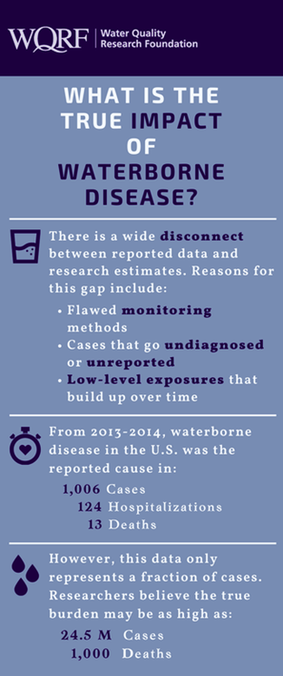|
Overview of Microbial Waterborne Disease in the U.S.
With Kelly Reynolds, PhD |
What are Biological Contaminants?
Biological contaminants are small organisms in water. They are also referred to as microbes or microbiological contaminants. Microbial contaminants in drinking water may cause either waterborne or water-based infections. Waterborne infections are caused by pathogens that originate in feces of infected animals or humans and are spread through the fecal/oral route of transmission. Only through the ingestion of feces can the pathogen spread to new hosts; thus person-to-person spread is also possible. Control of waterborne infections is focused on elimination of fecal contamination of source waters or removal of fecal contamination pre-consumption. |
Water-based infections are caused by pathogens that have a different life cycle than waterborne pathogens, and in many ways are much harder to control. These organisms are naturally present in water, having either originated from the aquatic environment or spent part of their life cycle in aquatic animals. They spread to human hosts via direct skin contact between the host and the water or through inhalation. Person-to-person transmission does not occur with water-based infections. Because the causative agents of water-based infections are indigenous to the water environment, the source water cannot be protected from contamination. Controls are primarily focused on minimizing growth of water-based pathogens.
|
Bacteria. Although bacteria tend to be more susceptible to drinking water disinfectants, they have the unique ability to persist in the environment in dormant stages or associated with biofilms that improve their chances of survival. Unlike viruses, bacteria are well adapted to grow outside of their host and may greatly increase in number given appropriate growth conditions. Regrowth of bacteria in hot water heaters (i.e., Legionella) and distribution systems (i.e., Pseudomonas) has led to adverse health outcomes and poor aesthetics.
Viruses. Viruses are less adept than bacteria at surviving outside of a host. However, human viruses have a low infectious dose, meaning only a small number are able to cause disease when ingested. Therefore, it is important that our tools for water monitoring have the ability to detect very low levels of viruses in large volumes of water. Compared to bacteria, waterborne viruses are generally more resistant to conventional drinking water treatment processes.
Protozoa. Protozoan parasites, such as Cryptosporidium, are extremely resistant to chlorine and thus require additional treatment for their removal (i.e., via filtration) or inactivation (via ultraviolet light). Cryptosporidium is frequently isolated from surface water, both before and after standard treatment. They too have a low infectious dose but do not have the ability to grow outside of invaded hosts. Wild animals and calves are commonly infected and known to shed massive amounts of protozoa into the environment, contaminating food and water supplies.
|




